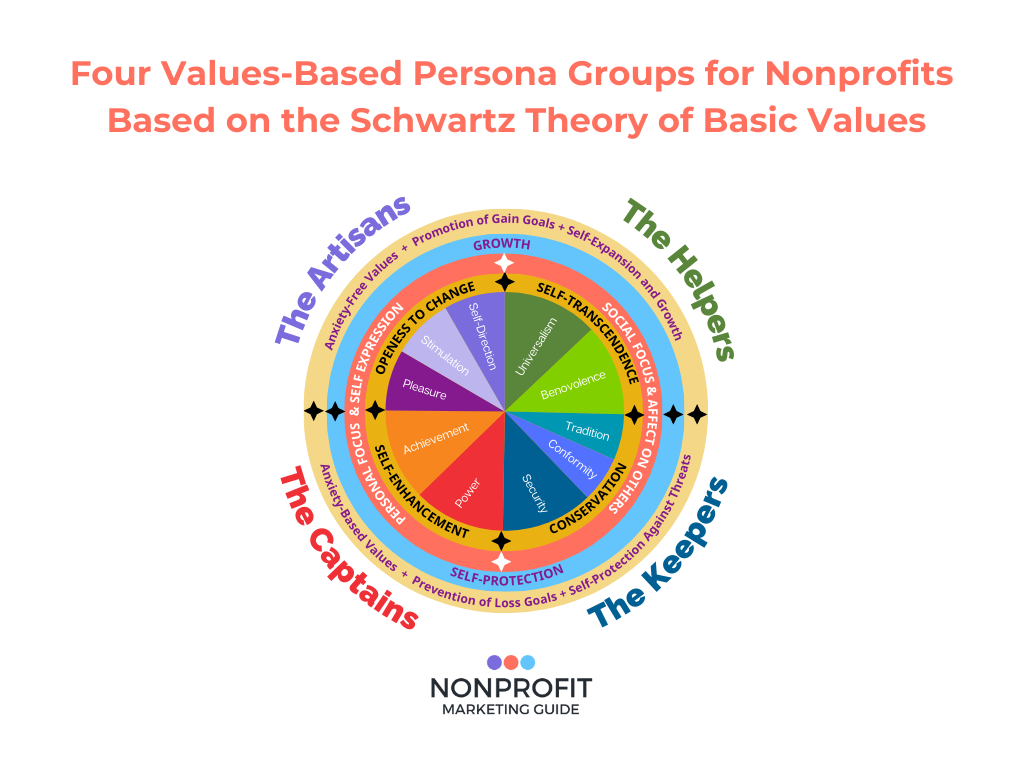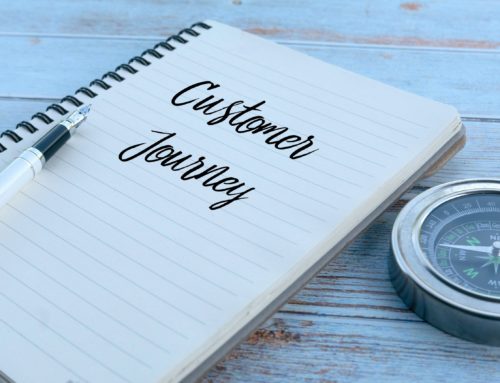
Knowing who you are talking to in your communications—who your target audience or personas are—is an essential part of any marketing strategy, even a “quick and dirty” one sketched out on a napkin.
But it’s hard to build personas customized to your nonprofit if you don’t have solid information on exactly who is on your mailing list.
That’s where research into universal and basic human values can help. The Schwartz Theory of Basic Human Values is a universal, cross-cultural model that outlines ten broad values that steer human behavior:
- Universalism
- Benevolence
- Tradition
- Conformity
- Security
- Power
- Achievement
- Pleasure (or Hedonism)
- Stimulation
- Self-Direction
If you dive into the research, you’ll find a tremendous amount of details, including what each of the ten values really means in terms of people’s motivations and decision-making.
To simplify this model for you so you can use it to inform your thinking about your target audiences or personas for your nonprofit, we’ve condensed the ten values into what we call the Four Values-Based Persona Groups:
- The Helpers
- The Keepers
- The Captains
- The Artisans
Now, let’s examine more closely how you can hone your messaging for each persona group and which brand archetypes naturally connect best. Remember, each value persona has defining goals and motivations. Do your calls to action and messaging match these values?
The Helpers
The Helpers embody the values of Universalism and/or Benevolence in Schwartz’s theory. They are socially focused and concerned about the effects on others. They have a growth mindset, and therefore are interested in “gain” goals or desires. In the nonprofit sector, desire can look like hope, dreams, comfort, and anything we want to provide for others.
Speak to the Helpers with messaging that appeals to their understanding and appreciation of others. That could be the support, love, and protection of all of humanity and nature. Or it could be the welfare of their specific communities of interest (their “in-group”).
The Helpers are the natural target audience for the Caregiver, Everyperson, and Lover brand archetypes for nonprofits. They can also work for the Innocent, Creator, and Jester archetypes.
The Keepers
In Schwartz’s theory, the Keepers embody the values of Tradition, Conformity, and Security. Like the Helpers, they are socially minded and concerned about the effects of their actions on others. But they are motivated by “loss” goals or fears rather than gain goals/desires like the Helpers. They want to prevent losses. That can look like defending people against anguish or injustice and preserving what they hold most dear.
Nonprofit language about fighting or stopping things from happening appeals to the Keepers. Communicate with them in a way that appeals to their desire for stability, discipline, moderation, loyalty, responsibility, respect, health, and/or humility.
The Keepers are the natural target audience for the Innocent and Hero brand archetypes for nonprofits. They can also work for the Everyperson, Ruler, Caregiver, and Sage archetypes.
The Keepers’ core value is Conservation.
The Captains
The Captains embody the values of Achievement and Power in Schwartz’s theory. Like the Keepers, they are motivated by the prevention of loss and self-protection against threats. But unlike the Keepers and the Helpers, they are more motivated by a focus on themselves and their own self-expression, rather than by the effect of their actions on others.
Your messaging to Captains must answer what’s in it for them. Appeal to their interest in success, influence, performance, prestige, ambition, authority, and/or control.
The Captains are the natural target audience for the Sage and Ruler brand archetypes for nonprofits. They can also work for the Explorer, Outlaw, Magician, and Hero archetypes.
The Captains’ core value is Self-Enhancement.
The Artisans
The Artisans are the fourth and final persona. They embody the values of Self-Direction, Stimulation, and Pleasure in Schwartz’s theory. Like the Captains, they are motivated by a focus on self and self-expression. But like the Helpers (and unlike the Keepers and Captains) they are motivated by gain goals and desires, rather than loss or fear. They are the persona most open to growth and change.
Speak to the Artisans with messaging that appeals to their independence, curiosity, creativity, freedom, exploration, excitement, pleasure-seeking, and/or enjoyment of life.
The Artisans are a natural fit for the Creator, Explorer, Outlaw, Magician, and Jester brand archetypes for nonprofits. They can also work for the Lover archetype.
The Artisans’ core value is Openness to Change.
Look Beyond the Helpers!
It’s natural to assume that everyone who supports a nonprofit is a Helper. They care about and want to support others. But don’t fall into the trap of thinking that Helpers are always the best personas to speak to! While it’s likely that most nonprofit supporters do share some of the values that define the Helpers, they may, in fact, be driven more strongly by some of the other values on the list.
Think about organizations that support competition, like those related to sports or achievement awards. Their supporters are likely to lean into Achievement or even Power values, which means they are Captains.
What about modern art, or activism for big social changes, or wildly creative approaches to solving problems? These are likely attractive to people who embrace Stimulation or Pleasure values and are welcoming of change — those are the Artisans.
Artisan values oppose those who favor Tradition, Conformity, or Security — we call them the Keepers. The Keepers are great value matches for many religious and historical/heritage nonprofits. But they could also work for organizations fighting to protect the erosion of current rights (think abortion rights, gay marriage, environmental protection).
What’s important to remember here is that the more you can limit your organization to one archetype and your target audiences to one values-based persona group, the better off you will be.






